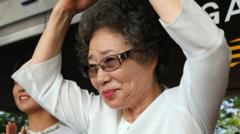As coffee shops in South Korea grapple with the rise of "Cagongjok," patrons who occupy tables for prolonged periods, the industry faces a challenge in balancing customer needs. While major chains like Starbucks implement guidelines to manage space, independent cafes adopt varied approaches. This phenomenon highlights broader societal issues, with some individuals using cafes as a refuge from their challenging backgrounds.
South Korean Cafes Face Dilemma Over Study Culture

South Korean Cafes Face Dilemma Over Study Culture
Cafes in South Korea are adjusting to the growing trend of students and workers using their spaces for extended study sessions, leading to mixed responses.
In the spirited district of Daechi, Seoul, café owner Hyun Sung-joo is confronting a growing concern among coffee shop proprietors: the phenomenon known as "Cagongjok," where predominantly young South Koreans study or work in cafés extensively. Hyun recounts an incident where a customer occupied a significant area with two laptops and a six-port power strip, prompting him to restrict access to power outlets. As café rent rises, he acknowledges the challenge of accommodating patrons who linger all day for their caffeine fix.
This trend of extended café use is particularly entrenched in South Korea compared to other nations, where students often socialize rather than seek study environments like cafés. Recently, Starbucks Korea reported an influx of complaints concerning those who bring elaborate setups into their outlets. As a response, they've initiated guidelines aimed at managing "extreme cases," where certain setups disrupt the experience for other customers. Starbucks reassured that while they wouldn't force patrons to vacate, they would offer guidance on proper café etiquette.
Despite these new guidelines, the moderate Cagongjok cohort, who frequent Starbucks for its conducive environment, continue to thrive. An 18-year-old dropout preparing for the university entrance exam revealed her routine of occupying a table for nearly 11 hours, sometimes leaving her items unattended while dining elsewhere. Recent visits to Starbucks indicate minimal alteration to customer behaviors, as some still leave belongings sitting while they step away.
Public reaction to Starbucks' policy has been a mix of support and dissent. Many patrons welcomed this development, considering the lifting of encroaching Cagongjok as a necessary step toward nurturing a social atmosphere in cafés. Others, however, lament the shift from Starbucks' previously lenient policy, suspecting it as a harmful retreat from open patronage.
This ongoing discussion reflects a deeper cultural context; the phenomenon of Cagongjok is intertwined with South Korea's evolving café industry, witnessing a 48% increase in coffee shops over five years approaching 100,000 establishments. Interestingly, a survey indicated that 70% of Gen Z job seekers utilize cafés for study at least weekly.
With independent cafés also impacted by the Cagongjok trend, their responses vary. While Hyun sees only a few extreme cases, he's allowing Cagongjok to coexist within his café as long as it aligns with mutual consideration. Some establishments have placed restrictions, implementing a "No Study Zone" policy after ongoing complaints regarding monopolization of space.
For many individuals, cafés offer more than coffee—they provide safe, comfortable spaces to study away from home or libraries. Yu-jin Mo, who faced odds growing up in foster care, finds the café setting less stifling than traditional study environments. Professor Choi Ra-young of Ansan University attributes this rise to South Korea's competitive environment, emphasizing that these youth are often navigating social and economic pressures that compel them toward cultures of shared space.
Professor Choi advocates for more inclusive café environments to accommodate this emerging cultural shift without disrupting other patrons, suggesting that recognizing Cagongjok’s complexities is vital to addressing all customers’ contentment in the café space.



















